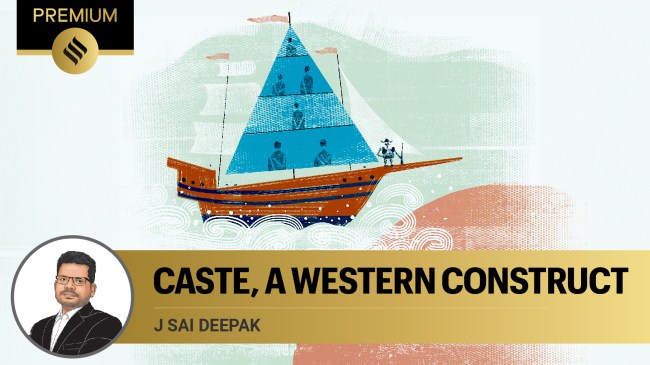Opinion J Sai Deepak writes: Why ‘caste’ is a Western construct
The formative literature on it dates to colonial times and is the work of writers with deep-rooted prejudices against Hinduism
 To acknowledge this reality is not to present an apologia for casteism or caste-based discrimination either in the past or the present, but to understand the system as it existed prior to its distortion. (Illustration by C R Sasikumar)
To acknowledge this reality is not to present an apologia for casteism or caste-based discrimination either in the past or the present, but to understand the system as it existed prior to its distortion. (Illustration by C R Sasikumar) In my previous article in this series on Dravidianism (‘A truth forsaken’, IE, January 15), I had discussed in some detail the “anthropological” mapping of Bharat’s society undertaken by Christian European missionaries through the alien lens of “caste”. Before I take this discussion further, a few important caveats are warranted lest my views are either misunderstood or misrepresented as a denial of the lived experience of affected groups, whoever they may be.
First, my objective is to understand the causes leading to the present, instead of falling prey to the common error of “presentism” that plagues contemporary discourse on issues such as “caste/tribe”. This means the past must be understood in terms of the past, not to condone or glorify it, but to avoid the distortion caused by the lens of the present. Importantly, it would defy logic for a post-colonial society such as Bharat to not even examine the past and continuing religious, cultural and politico-legal impact of colonialism on itself.
Second, in the second part of this series (‘The colonial-missionary roots of caste and tribe’, IE, November 7, 2023), I had clearly qualified my position on the issue of “caste/tribe” that in attributing the introduction of these lenses to the missionary-colonial combine, the intent was not to deny the prior existence of the varna-jati complex, its hereditary nature and the identity silos associated with it. However, it is certainly my case, based on scholarly literature, that the application of the “caste/tribe” classifications by the Christian colonial establishment (especially through an official census-taking exercise) resulted in an artificial re-ordering of the Hindu society based on the European perception of it. Interestingly, the 1911 census of Bengal records the existence of at least 80 different castes even in the Muslim society. So much for monotheistic egalitarianism.
In other words, “castification” of the pre-existing varna-jati complex resulted in presenting an outside and incorrect view of how the complex operated, including its structure, rigidity and the scale of atrocities arising from “caste-consciousness”. Such missionary-colonial distortion was not unique to the varna-jati structure, it was equally visible in representations of the Devadasi system, Sati and the Jagannath Rath Yatra. In fact, the European approach was no different in Africa, Australia or the Americas. No wonder, they are significantly Christian. One could go a step further and contend that the original template was crafted during the Christianisation of Europe itself against its pre-Christian societies, which was then applied during the colonial period in other continents. When understood against this larger backdrop, which reveals a commonality and continuity of thought, action and outcomes, it becomes evident that “caste”, Devadasi, Sati and Jagannath Yatra, inter alia, were tools in the hands of the missionary-colonial compact to malign the Hindu society to create the “humanitarian” justifications needed for religious, cultural and politico-legal intervention.
On how the Devadasis were branded and reduced to “temple prostitutes”, Women of Pride: The Devadasi Heritage by Lakshmi Vishwanathan is a good read, and on Sati, I would strongly recommend Meenakshi Jain’s seminal work Sati: Evangelicals, Baptist Missionaries, and the Changing Colonial Discourse. As for the malicious vilification of the Jagannath Rath Yatra, the credit for it goes to Claudius Buchanan, a Scottish Missionary from the Church of England, who solicited contributions from his followers in England to save Hindus from their “bloody, violent, superstitious and backward religious system”. Given these documented examples of vile misrepresentation of Hinduism and Bharat, whose underlying goal was dehumanisation followed by proselytisation, it is indeed surprising that there is stubborn resistance even from sections of the contemporary non-Left — and not just the Left — in Bharat to acknowledge that the varna-jati complex too has been subjected to distortion by the Christian West through application of the caste/tribe lenses.
Finally, to acknowledge this reality is not to present an apologia for casteism or caste-based discrimination either in the past or the present, but to understand the system as it existed prior to its distortion. This approach is more likely to throw up solutions which are original and practicable being rooted in the culture and realities of this land, instead of slavishly applying the Christian colonial template that has only worsened the caste discourse to the detriment of the Hindu society and to the advantage of vested interests. For all the so-called clarion calls for the “annihilation of caste” since before and after Independence, if anything, we are far from it and “caste” has become more deeply entrenched in politics, policies, social and electoral discourse in “independent Bharat” thanks to the perpetuation of the colonial approach. And yet, there is a mulish and anti-intellectual, perhaps even motivated, refusal to research and understand the distinctions between the varna-jati complex and caste/tribe classifications to address contemporary social challenges and the relentless anti-Dharmic pamphleteering.
I hope the above caveats serve to convey my position better, even to those who wish to disagree with integrity. I will now continue the discussion on the emergence of the caste/tribe categories and the mythical Dravidian identity from the “anthropological service” provided by Christian missionaries in Southern Bharat to colonial rulers. I had ended the last article with the reference to the publication in 1816 by the British East India Company of the “caste” scholarship compiled by French Catholic Missionary Abbé Jean-Antoine Dubois, which was based on the earlier work of a Pondicherry-based French Jesuit Missionary, Gaston-Laurent Coeurdoux (Père Coeurdoux). This work would go on to inform the Company’s views on Hindu society and its subsequent administrative and social engineering policies, especially in Madras, for at least half a century. Interestingly, Max Müller, that patron saint of Indology, underscored the importance of Dubois’ work and eulogised him as a “man singularly free from prejudice” and “a scholar with sufficient knowledge, if not of Sanskrit, yet of Tamil”. But how free of prejudice was Dubois?
According to Nicholas Dirks, while Dubois attributed the achievements of the Hindu civilisation to the moral obligations imposed by the “caste system”, he bemoaned that Brahmins were the primary roadblock to the Christianisation of the Hindu society. As for his views on the group previously known as the “Pariahs”, propriety prevents me from repeating them and I suspect sympathisers of Dubois wouldn’t want that either. Let’s just say that Dubois’ contempt for the aforementioned group was unvarnished and rivalled Aurangazeb’s “love” of Hindus, so much so that Dubois felt that the mission to convert Hindus to Christianity would be a failure if it could attract only “untouchables” and not the Brahmins. If this was a “man singularly free from prejudice” according to the great Max Müller, I don’t know who would qualify as a person with prejudice. Such were the people who put together the early formative literature on “caste” and “Indology” which academic and popular discourse parrots till date. I shall continue in the next article.
The writer is a commercial and constitutional litigator who practises as a counsel before the Supreme Court of India, the High Court of Delhi, the NCLAT and the CCI, and author of India that is Bharat: Coloniality, Civilisation, Constitution, and India, Bharat and Pakistan: The Constitutional Journey of a Sandwiched Civilisation





